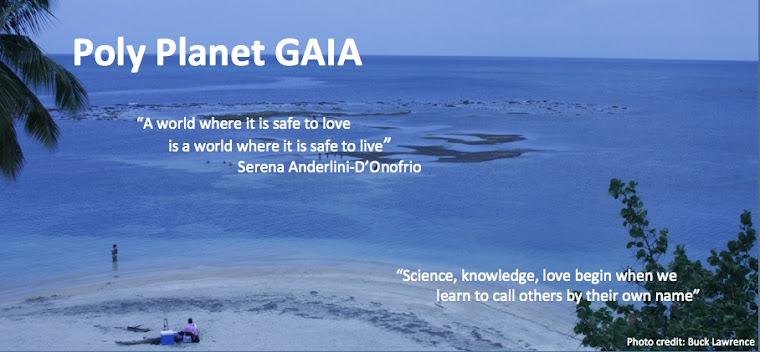 |
| Cindy Baker: Ecosex Pride Flag |
The course is dedicated to
exploring ecosexuality, as a social movement, a style of amorous and creative
expression, a cosmic theory, an orientation, and a practice of love.
What is ecosexuality? How did the concept come about and why it matters? How can it help us to explore the intersections between ecology and sexuality, science and the humanities, global and personal health and love? How does ecosexuality intersect with other orientations and practices of love, including those common among gays, bis, straights, polys, swingers, metrosexuals, and so on? How does ecosexuality contribute to defining our relationship to the environment, to technology, the natural elements, and the web of life that sustains our species? Is nature our enemy, mother, hostess, lover, all of the above?
A number of recent sources touch on the theme of ecosexuality. They include books and articles that study and analyze cultural expression, films, dvds, websites, and other educational and documentary cultural texts. Some of those in the assigned and optional reading lists may include: Sexual Fluidity, by Lisa Diamond; Sex at Dawn, by Christopher Ryan and Calcida Jetha; Gaia and the New Politics of Love, by Serena Anderlini; Polyamory in the 21st Century, by Deborah Anapol; Mystery Dance, by Lynn Margulis and Dorion Sagan; Microcosmos and Acquiring Genomes by Lynn Margulis; Sirens, by John Duigan; Shortbus, by John Cameron Mitchell; An Inconvenient Truth, by Davis Guggenheim; Sluts and Goddesses by Annie Sprinkle, Love Art Lab by Annie Sprinkle and Beth Stephens; French Twist by Josiane Balasko, The Ignorant Fairies by Ferzan Ozpetek, and Science of Panic, by Patrizia Monzani.
What is ecosexuality? How did the concept come about and why it matters? How can it help us to explore the intersections between ecology and sexuality, science and the humanities, global and personal health and love? How does ecosexuality intersect with other orientations and practices of love, including those common among gays, bis, straights, polys, swingers, metrosexuals, and so on? How does ecosexuality contribute to defining our relationship to the environment, to technology, the natural elements, and the web of life that sustains our species? Is nature our enemy, mother, hostess, lover, all of the above?
A number of recent sources touch on the theme of ecosexuality. They include books and articles that study and analyze cultural expression, films, dvds, websites, and other educational and documentary cultural texts. Some of those in the assigned and optional reading lists may include: Sexual Fluidity, by Lisa Diamond; Sex at Dawn, by Christopher Ryan and Calcida Jetha; Gaia and the New Politics of Love, by Serena Anderlini; Polyamory in the 21st Century, by Deborah Anapol; Mystery Dance, by Lynn Margulis and Dorion Sagan; Microcosmos and Acquiring Genomes by Lynn Margulis; Sirens, by John Duigan; Shortbus, by John Cameron Mitchell; An Inconvenient Truth, by Davis Guggenheim; Sluts and Goddesses by Annie Sprinkle, Love Art Lab by Annie Sprinkle and Beth Stephens; French Twist by Josiane Balasko, The Ignorant Fairies by Ferzan Ozpetek, and Science of Panic, by Patrizia Monzani.
Research projects will be required. Writing for the course may be considered for inclusion in an anthology on ecosexuality.
Note: The first edition of this course will be taught at the University of Connecticut, Storrs, in the Spring of 2013. It will be designed as a seminar in the WGSS Department. If you are interested in enrolling or auditing, please contact the professor or department.

No comments:
Post a Comment